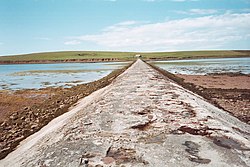Hunda: Difference between revisions
Created page with "{{Infobox island |name=Hunda |norse=Hunðey |county=Orkney |picture=Hunda_Causeway.jpg |picture caption=The causeway to Hunda, seen from the Burray side |os grid ref= ND438696..." |
No edit summary |
||
| (One intermediate revision by one other user not shown) | |||
| Line 8: | Line 8: | ||
|latitude=58.854939 | |latitude=58.854939 | ||
|longitude=-2.97474 | |longitude=-2.97474 | ||
|area=250 acres | |||
|area= | |highest height=138 ft | ||
|highest height= | |||
|population=0 | |population=0 | ||
}} | }} | ||
'''Hunda''' is an uninhabited island of [[Orkney]], of | '''Hunda''' is an uninhabited island of [[Orkney]], of 250 acres in extent and rising to 138 ft above sea level. It lies in [[Scapa Flow]] and is connected to the nearby island of [[Burray]] by a causeway built in 1941 to stop passage of small surface craft as part of the boom defences barring the western entrances to Scapa Flow. Burray in turn is joined to [[Mainland, Orkney|Mainland]] by way of the [[Churchill Barriers]].<ref>Wenham, Sheena, ''The South Isles'' in Omand, Donald (ed.) (2003) ''The Orkney Book''. Edinburgh. Birlinn. Page 211.</ref> | ||
The name is derived from the Old Norse for 'dog island'; ''Hunðey''. | The name is derived from the Old Norse for 'dog island'; ''Hunðey''. | ||
Latest revision as of 16:44, 25 November 2018
| Hunda | |
 The causeway to Hunda, seen from the Burray side | |
|---|---|
| Location | |
| Location: | 58°51’18"N, 2°58’29"W |
| Grid reference: | ND43869680 |
| Area: | 250 acres |
| Highest point: | 138 ft |
| Data | |
| Population: | 0 |
Hunda is an uninhabited island of Orkney, of 250 acres in extent and rising to 138 ft above sea level. It lies in Scapa Flow and is connected to the nearby island of Burray by a causeway built in 1941 to stop passage of small surface craft as part of the boom defences barring the western entrances to Scapa Flow. Burray in turn is joined to Mainland by way of the Churchill Barriers.[1]
The name is derived from the Old Norse for 'dog island'; Hunðey.
The island is rich in bird life,[2] and contains a disused quarry. A small inlet in the northern cliffs is known as 'Sunless Geo'.
Hunda is currently used to for grazing; both sheep and goats graze here.[3]
Outside links
| ("Wikimedia Commons" has material about Hunda) |
References
- ↑ Wenham, Sheena, The South Isles in Omand, Donald (ed.) (2003) The Orkney Book. Edinburgh. Birlinn. Page 211.
- ↑ Haswell-Smith, Hamish (2004). The Scottish Islands. Edinburgh: Canongate. ISBN 1841954543.
- ↑ South Ronaldsay & Burray
| Islands of Orkney |
|---|
|
Inhabited islands: |
